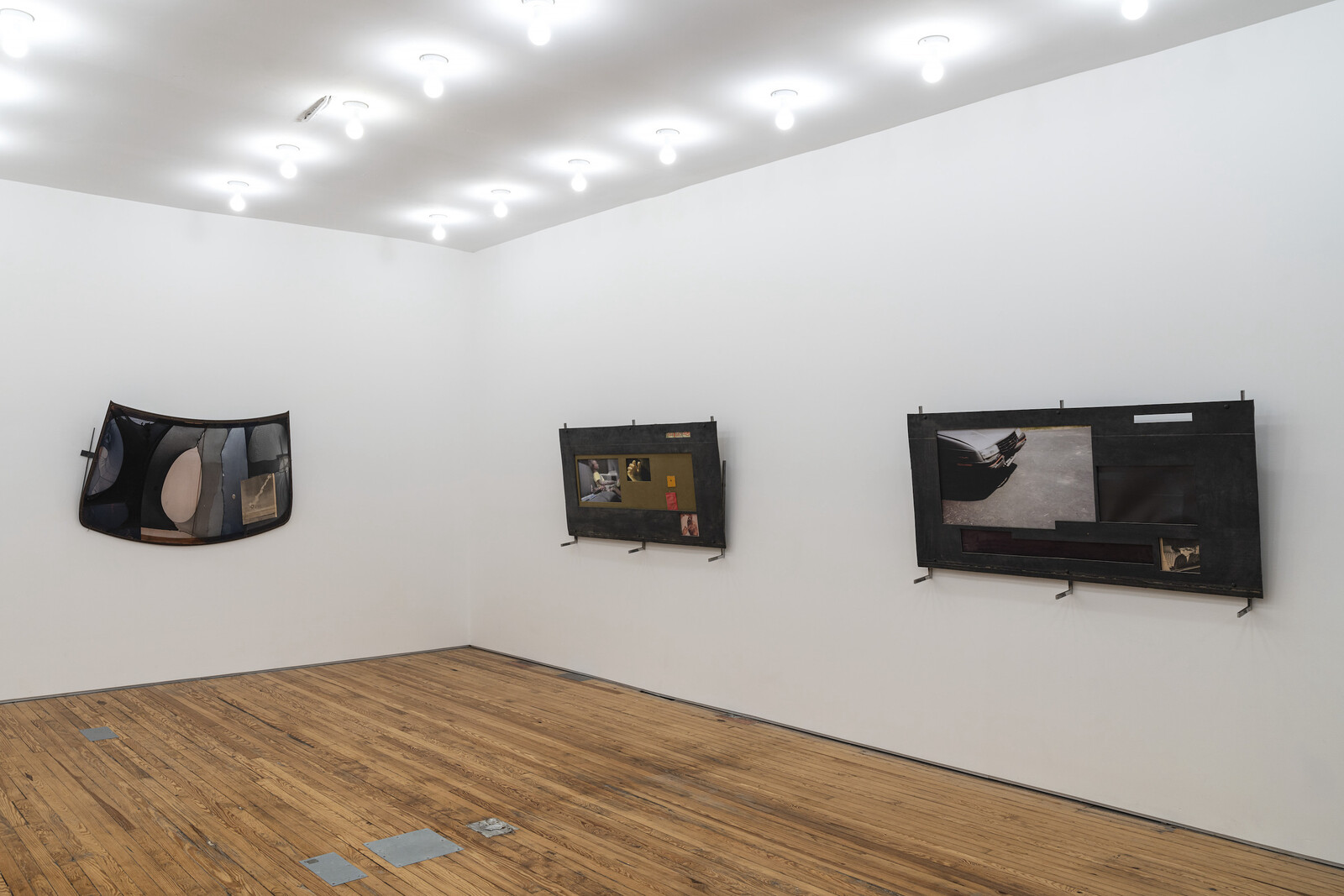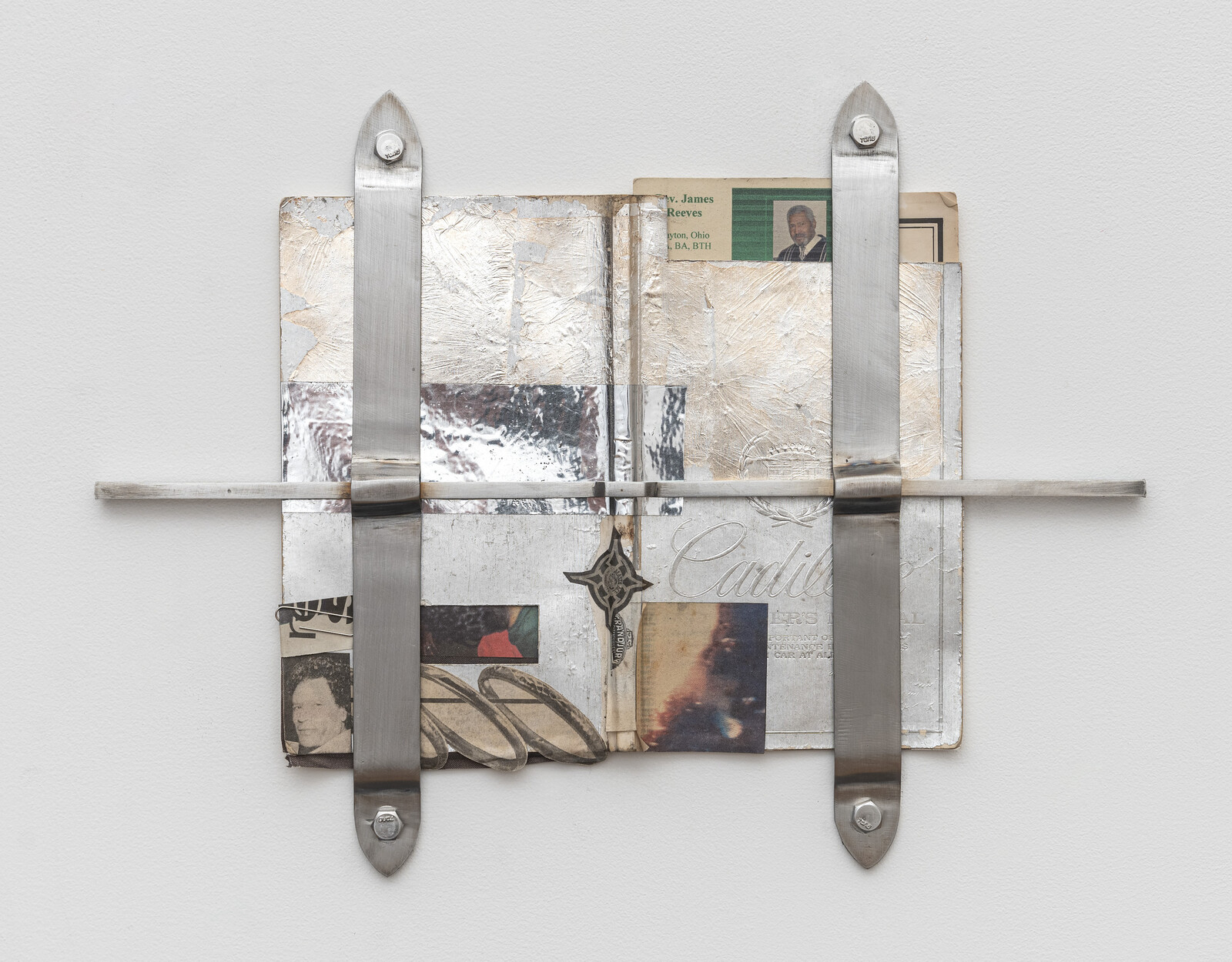Y. Malik Jalal’s steel sculptures serve as picture frames for his found photographs. Newspaper clippings, magazine covers, business cards, and screengrabs from traffic camera footage, once incorporated into the New Haven- and Atlanta-based artist’s somber color palette and subjected to his arrangements and juxtapositions, evoke an aesthetics of abjection, conjuring car accidents from which one cannot, despite one’s better judgment, look away.
In the wall-mounted assemblage WARP NO. 1 (all works 2024), a large print of the dented front bumper of a gray jalopy looms over a much smaller black-and-white photo of a veiled Princess Diana. In light of this juxtaposition, the high-speed collision that fatally injured the English royal in 1997 seems prefigured in her downcast eyes. Both images are set in a flat, steely-gray frame that, like the old car, appears scuffed, dusty, and dilapidated but not quite vintage—decommissioned but unable to rest. In WARP NO. 2, Jalal presents an image of a crash test dummy strapped in the backseat of a car. At the bottom right of the panel, positioned like addenda, are a grimy red lens cloth advertising Harrigan Inc., a Connecticut-based home and auto insurance agency, and a photo of an actor’s face covered in special effects makeup: the stringy, mauve silicone made to mimic rotted flesh is both viscerally off-putting and inexplicably captivating.
Beyond the intimations of violence, Jalal’s exhibition offers critiques of the ways in which perceptions of value are propagated through print and visual culture. Here, the artist positions the fleeting acquisition of social status as a Pyrrhic victory whose cost is violence and destruction. In a small untitled collage made on a Cadillac owner’s manual, we see sheets of silver leaf pressed around the embossed logo of the luxury vehicle, a signifier of upward mobility, particularly in Black communities (Cadillac was among the first car companies to sell to African Americans in the 1930s). Hanging on the wall opposite this collage is Regular Pedestrians, a larger work consisting of a steel frame shaped like a Maltese cross, which contains a pixelated image of a car accident resulting from what the exhibition materials call a “high speed chase.” A rust-colored vehicle has been totaled on a median; the driver and passenger flee on foot. Between these depictions of fulfilment and catastrophe hangs a work titled ballistic body, in which a fragmented image of blurred headlights under wisps of blood-orange clouds sits inside a silver crosshair-shaped frame, such that the cinematic romance of “driving into the sunset” is soured by a twinge of paranoia. Elsewhere in the gallery, an enlarged photo of a fiery highway explosion captured on a traffic camera, framed in a sculpture titled Fleeing and Eluding, provides the most explicit critique of the fabled freedom of driving a fast car on the interstate highways.
By juxtaposing sensational security footage like that which captured the accidents in Regular Pedestrians and Fleeing and Eluding with printed advertisements—for the Cadillac Eldorado as well as for “Dollar Days” at Valu-Rite—Jalal elegizes the relationship between the marginalized American subject and symbols of physical and social mobility. The advertising copy seduces in a kind of coded language, of a piece with Jasmine Gregory’s glitter-smeared oil paintings (on view concurrently at MoMA PS1 in a show titled “Who Wants to Die for Glamour”) which combine images of affluent white fathers and sons with the appropriated slogan, “You never actually own a Patek Philippe. You merely look after it for the next generation.” Jalal’s fatalistic attitude toward car culture meanwhile finds a counterpart in the artist Sara Cwynar’s concurrent exhibition “Baby Blue Benzo” at 52 Walker: in a 22-minute montage about the 1955 Mercedes-Benz 300 SLR, the most expensive automobile to be sold at auction, Cwynar’s fetishistic meditation on the idea and image of the €135 million sportscar is intensified by a cinematic shot of a freight truck exploding on a highway, which flashes across the screen for a few seconds, a blip in the wash of commodity worship.
Like Gregory’s paintings and Cwynar’s video, Jalal’s eclectic sculptures catalogue a sense of stagnation, nostalgia, and ambivalence towards consumerism and the media landscape. Where his contemporaries fall short of dismantling their own fascination with glamor, however, Jalal does not appear to be seduced by it. His exhibition’s stubbornly sincere, almost moralizing work —spurred by a morbid fixation on images of car accidents—represents the human toll of contemporary culture at the intimate scale it deserves.






